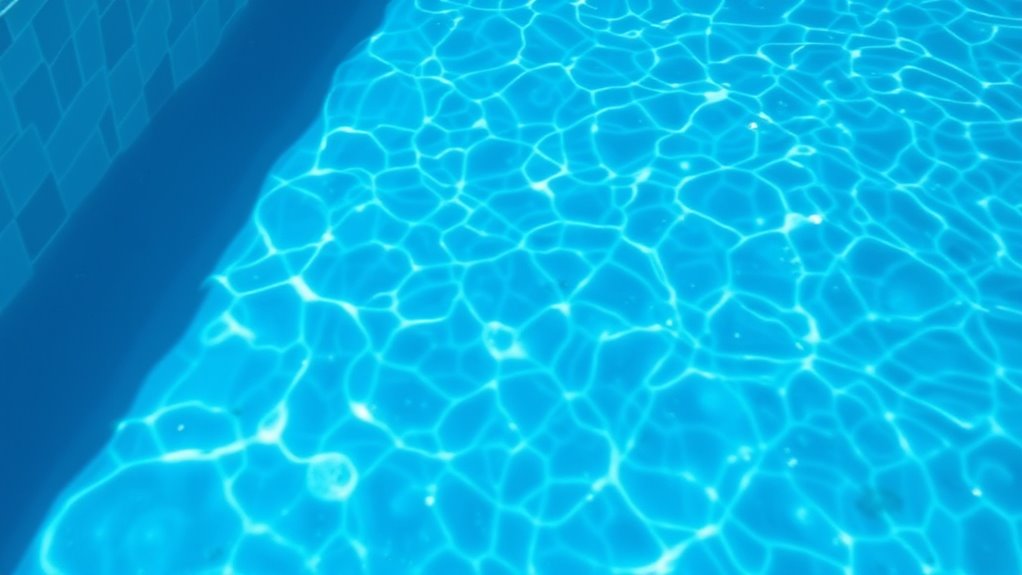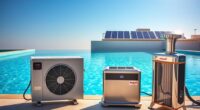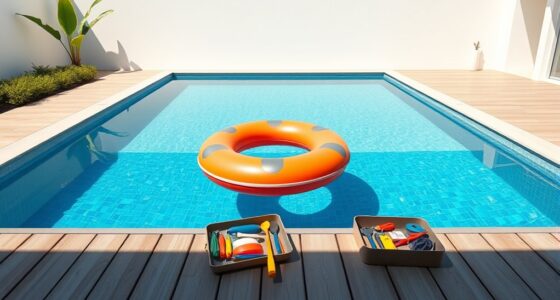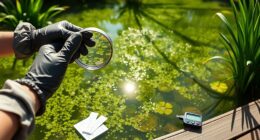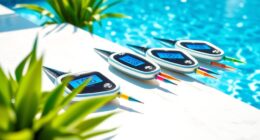To clear cloudy water in your Endless Pool, start by checking and balancing your water chemistry, ensuring pH and sanitizer levels are correct. Regularly clean or replace your filters and maintain proper circulation for ideal filtration. Remove organic debris and control algae with appropriate chemicals and covers. If water remains cloudy despite these efforts, it’s time to look deeper into system adjustments or seek expert advice to keep your pool crystal clear.
Key Takeaways
- Regularly test and balance water chemistry, including pH, alkalinity, and sanitizer levels, to prevent cloudiness.
- Clean or replace filters frequently to ensure proper water circulation and filtration efficiency.
- Remove organic debris and use clarifiers or algaecides as needed to maintain water clarity.
- Ensure the circulation system runs 8-12 hours daily and that return jets promote even water movement.
- Address persistent issues by consulting a professional to diagnose equipment or chemical imbalances.
Identifying Common Causes of Cloudy Water
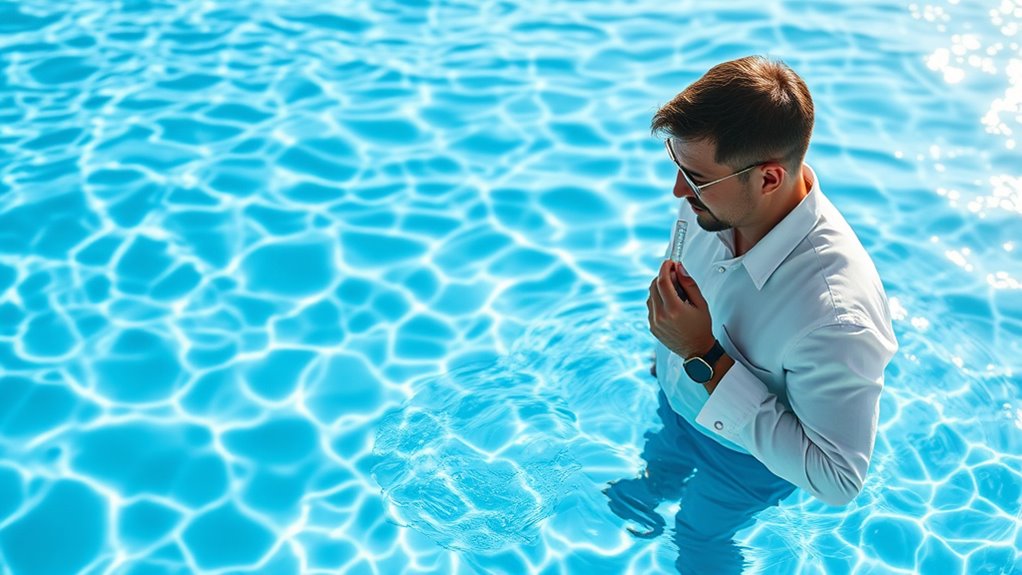
Cloudy water can be caused by several common issues that you can often identify and address yourself. One typical cause is excess organic matter, like leaves, dirt, or oils, which can cloud the water if not removed regularly. Another frequent culprit is poor filtration; a dirty or clogged filter can’t effectively remove debris, leading to cloudiness. Additionally, high levels of dissolved solids or minerals, such as calcium or magnesium, can cause the water to appear cloudy or milky. Sometimes, inadequate water circulation results in stagnation, encouraging particles to suspend in the water. Finally, overuse of chemicals like algaecides or improper chemical balancing can disturb water clarity. Recognizing these signs allows you to take prompt action before the issue worsens. Proper filter maintenance is essential to ensure your pool stays clear and inviting.
Checking and Balancing Water Chemistry
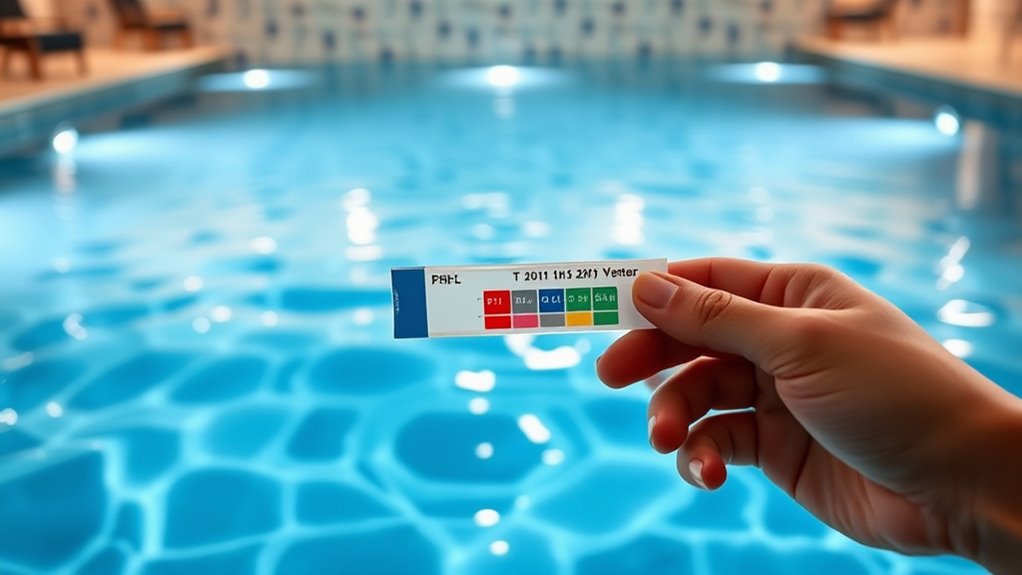
Maintaining proper water chemistry is essential for clear, healthy water. You should regularly test your pool’s pH, alkalinity, and sanitizer levels using reliable test kits. Aim for a pH between 7.2 and 7.6 to prevent irritation and cloudiness. If the pH is too high or low, adjust it with pH increasers or decreasers accordingly. Balancing alkalinity helps stabilize pH and prevents fluctuations that can cause cloudiness. Check sanitizer levels—chlorine or bromine—to ensure they stay within the recommended range, typically 1-3 ppm. If levels are off, add sanitizer to kill bacteria and algae that contribute to cloudiness. Consistent testing and adjusting keep your water balanced, reducing the risk of cloudiness and maintaining a safe, inviting pool environment. Incorporating data-driven strategies can also enhance your troubleshooting efforts and ensure optimal water quality.
Ensuring Proper Filtration and Circulation
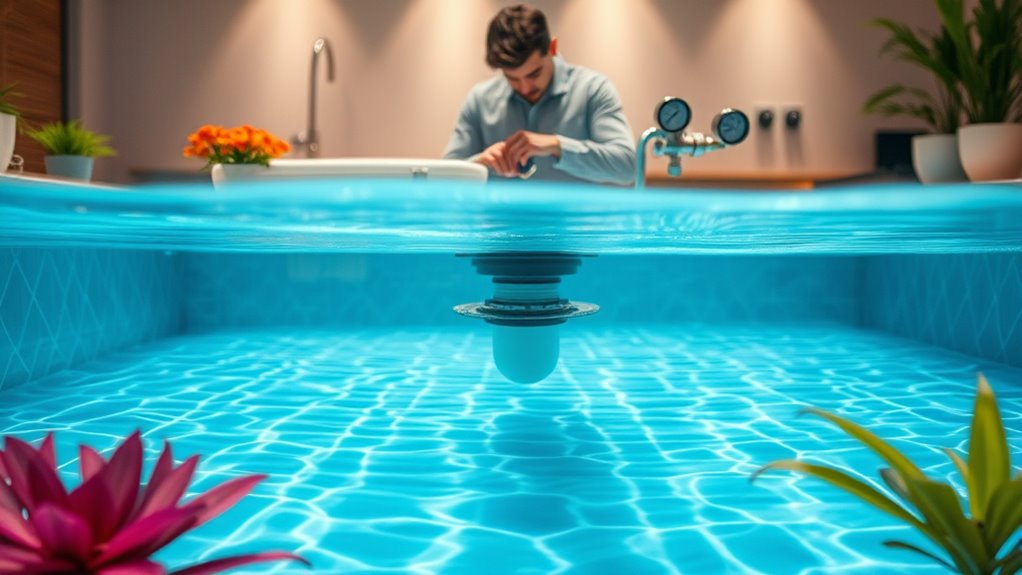
Proper filtration and circulation are essential for keeping your pool water clear and healthy. They remove debris, distribute chemicals evenly, and prevent stagnant spots where bacteria can grow. To ensure maximum performance, check that your pump and filter are appropriately rated for your pool size. Regularly clean or replace your filter media to maintain efficiency. Make sure your circulation system runs long enough each day—aim for at least 8-12 hours. Additionally, position return jets to promote even water movement, avoiding dead zones. Proper system design plays a crucial role in achieving optimal water quality. Here are key tips to optimize your system:
- Clean filters regularly
- Verify pump flow rates
- Run the pump during peak usage
- Adjust return jet angles
- Inspect and repair leaks promptly
Managing Algae and Organic Contaminants

To keep algae and organic contaminants under control, you need effective prevention strategies and regular debris removal. Implementing proper circulation and monitoring nutrient levels can markedly reduce algae growth. Staying proactive with these steps helps maintain clean, healthy water. Additionally, fostering a creative approach to troubleshooting can lead to innovative solutions for water quality issues.
Algae Prevention Strategies
Have you ever wondered how to keep algae from taking over your water system? Prevention is key. Start by maintaining proper sanitizer levels to inhibit algae growth. Regularly clean and brush your pool surfaces to remove any initial algae footholds. Make certain your filtration system runs efficiently, filtering out nutrients that algae feed on. Control sunlight exposure by using covers or tinted windows, as sunlight fuels algae growth. Finally, balance your water chemistry consistently to prevent nutrient buildup. Incorporate natural materials like wooden toys to avoid introducing synthetic chemicals that could disrupt water quality.
- Use algaecides as a preventive measure, not just a cure
- Limit nutrient sources like phosphates and nitrates
- Keep pH levels between 7.2 and 7.6
- Run your pump and filter daily, especially during warm months
- Install UV or ozone systems for added algae control
Organic Debris Removal
Removing organic debris is a vital step in maintaining water clarity and preventing algae outbreaks. Leaves, dirt, and organic matter can fuel algae growth and cloud your pool water. Regularly skim the surface and vacuum the bottom to eliminate debris before it decomposes. Using a fine mesh net ensures you catch even tiny particles. Proper filtration also helps remove suspended organics. Consider testing your water for nutrient levels to identify sources of contamination. To illustrate, here’s a quick overview:
| Debris Type | Removal Method | Prevention Tips |
|---|---|---|
| Leaves & Dirt | Skimming & Vacuuming | Cover your pool when not in use |
| Organic Matter | Filtration | Regular water testing |
| Algae Spores | Shock Treatment | Maintain proper chemical balance |
Stay consistent, and you’ll keep your Endless Pool clear and inviting. Additionally, understanding water chemistry can help you adjust chemical levels effectively to prevent future issues.
Using Clarifiers and Flocculants Effectively
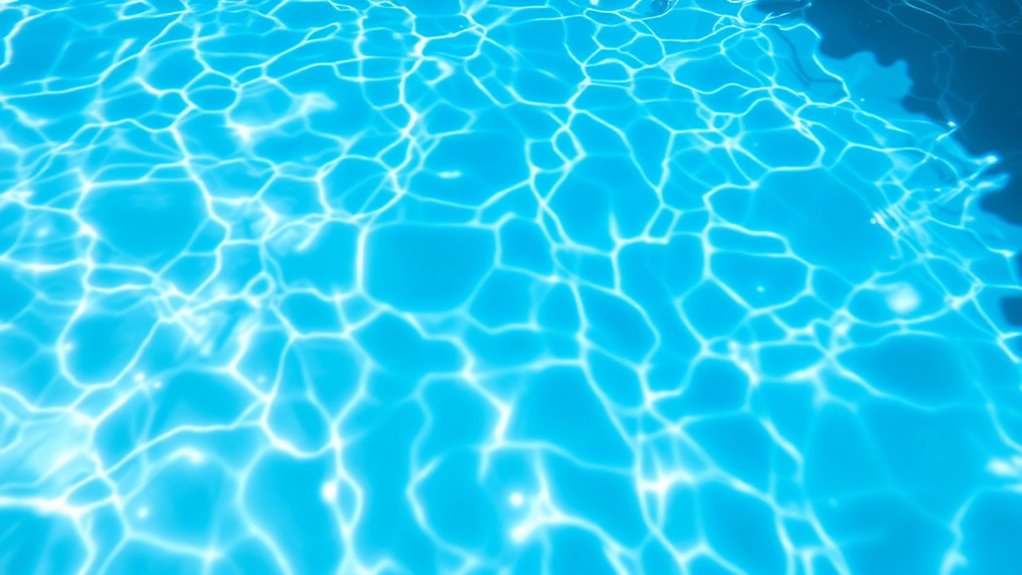
To use clarifiers and flocculants effectively, you need to follow proper dosage guidelines to avoid over- or under-treatment. Timing is essential; applying these agents at the right moment ensures maximum particle removal. Keep these points in mind to optimize water clarity and maintain quality.
Proper Dosage Guidelines
Using the correct dosage of clarifiers and flocculants is essential for effective water treatment. Overdosing can cause cloudiness or cloudy water, while underdosing leaves particles suspended, requiring more frequent treatments. Always follow the manufacturer’s instructions carefully, adjusting based on your pool’s size and water condition. Use a reliable measuring tool to ensure accuracy. Regularly test your water to determine if additional clarifier or flocculant is needed. Remember, consistency is key for maintaining clear water. Proper dosing prevents waste and reduces chemical imbalance.
- Read product labels thoroughly before use
- Measure precisely to avoid over-application
- Adjust dosage based on water clarity and test results
- Avoid mixing different chemicals without guidance
- Store chemicals in a cool, dry place to preserve effectiveness
Application Timing Tips
Timing is crucial when applying clarifiers and flocculants to guarantee they work effectively. You should add these chemicals when the water is calm and free of agitation, allowing them to settle properly. Avoid adding them during vigorous filtration or splashy activities that can disperse the particles. For best results, introduce the clarifier or flocculant gradually, followed by gentle circulation to distribute evenly. Wait at least 2 hours before testing and evaluating clarity, giving the chemicals time to act. Proper water tuning can significantly improve the efficiency of the treatment process.
Regular Maintenance and Preventative Measures

Regular maintenance and preventative measures are essential for keeping your water quality ideal and avoiding costly issues down the line. By staying proactive, you prevent buildup, bacteria growth, and equipment damage. Consistently check and clean your filters to ensure proper water flow. Test your water chemistry weekly, adjusting pH and sanitizer levels as needed. Keep the water balanced to prevent cloudiness and algae. Regularly inspect the pool’s surfaces and equipment for wear or leaks. Use algaecide and clarifiers periodically to maintain clarity. Additionally, cover your pool when not in use to minimize debris and contamination. Staying disciplined with routine upkeep helps you enjoy clear, healthy water and extends your pool’s lifespan, saving you time and money in the long run.
When to Seek Professional Assistance
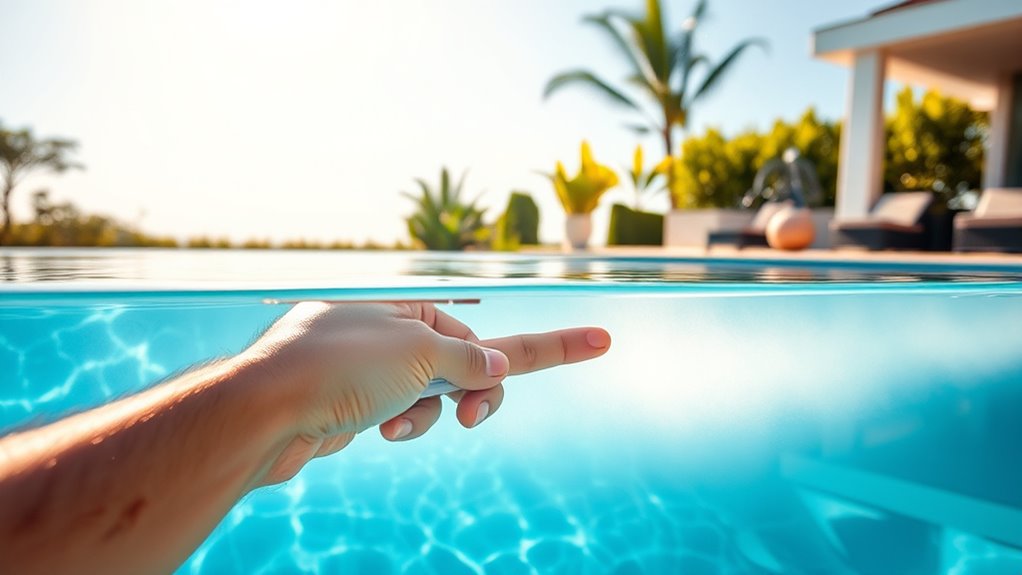
Even with diligent maintenance, there are times when issues go beyond routine fixes and require expert intervention. If you notice persistent cloudiness, foul odors, or algae that won’t clear, it’s a sign you need professional help. Similarly, if water testing reveals abnormal chemical levels despite your efforts, a specialist can diagnose underlying problems. Sudden changes in water clarity or performance issues, like equipment failure or persistent bacteria, also warrant expert attention. When troubleshooting doesn’t resolve the issue within a reasonable timeframe, or if you’re unsure about handling chemical adjustments safely, it’s best to contact a pool professional. Their expertise guarantees your pool stays clean, safe, and enjoyable. Proper water chemistry management is essential for maintaining clear and healthy water in your pool.
Frequently Asked Questions
Can Hard Water Cause Persistent Cloudiness in Pools?
Yes, hard water can cause persistent cloudiness in pools. The high mineral content, especially calcium and magnesium, can lead to buildup on pool surfaces and within the water, making it appear cloudy. To fix this, you should test your water’s hardness levels and consider using a water softener or sequestering agents. Regular maintenance, including balancing pH and adding clarifiers, also helps keep your pool clear and inviting.
How Often Should I Replace Pool Filters to Prevent Cloudiness?
You should replace your pool filters every 1 to 2 years, depending on usage and water quality. Regularly cleaning and backwashing your filters can extend their lifespan and maintain ideal performance. If you notice persistent cloudiness despite cleaning, it’s time to replace the filter. Proper filtration keeps your water clear, healthy, and free of debris, ensuring your Endless Pool stays inviting and safe to swim in.
Are Natural Remedies Effective for Clearing Cloudy Water?
Think of natural remedies as gentle whispers from nature trying to clear your pool’s murkiness. They can help, but they aren’t magic cures. Often, they work best when combined with proper filtration, chemical balancing, and regular maintenance. While ingredients like baking soda or algae scrubbers might boost clarity, don’t rely solely on them. For truly clear water, stick with proven methods, and natural remedies can be your helpful sidekick.
What Are the Signs of a Failing Circulation Pump?
You’ll notice your circulation pump is failing if the water isn’t circulating properly, leading to cloudy or stagnant water. You might hear unusual noises, notice reduced water flow, or see the pump vibrating excessively. If the pump stops working altogether or you observe leaks around it, these are clear signs it’s on its way out. Address these issues promptly to prevent water quality problems and keep your pool functioning smoothly.
How Do Temperature Fluctuations Impact Water Clarity?
Temperature fluctuations can wreak havoc on your pool’s clarity, turning crystal-clear water into a murky, swamp-like mess overnight. When temps swing wildly, it disrupts chemical balance and creates perfect conditions for algae and bacteria to thrive. You might notice your water looking more cloudy or green than usual, making every swim feel like a dip in a questionable pond. Keeping a steady temperature helps maintain that pristine, inviting sparkle you crave.
Conclusion
Maintaining clear water in your endless pool is like tending a delicate garden—each action nurtures its clarity and health. By regularly checking chemistry, ensuring proper filtration, and managing organic growth, you’re tending the roots of your oasis. When issues persist, don’t hesitate to call in a professional—sometimes, the most profound clarity comes from expert hands. With consistent care, your pool remains a pristine reflection of serenity, a symbol of your dedication and harmony.
